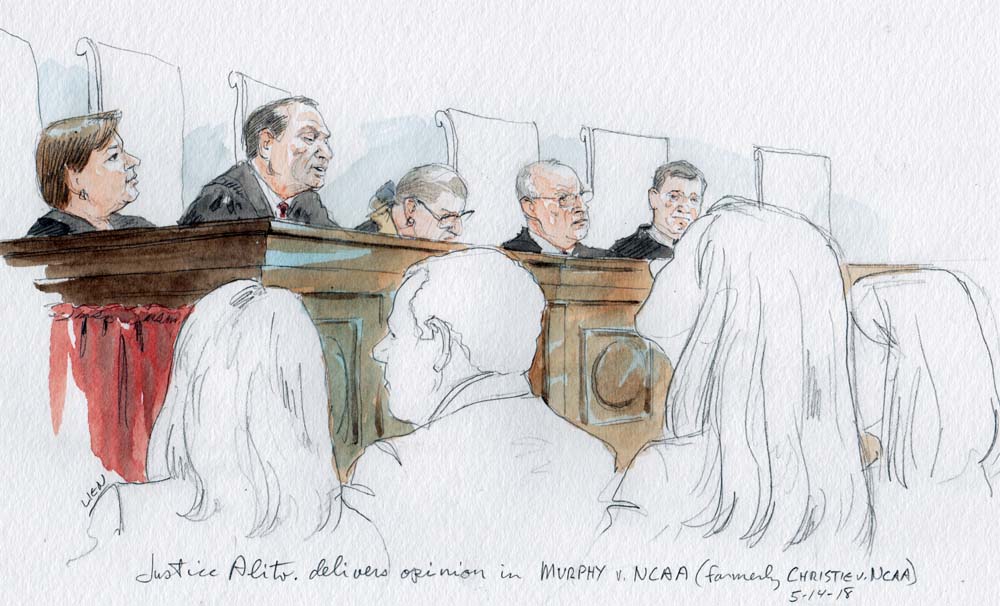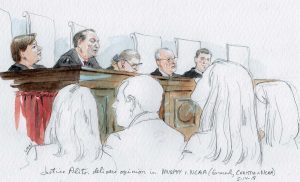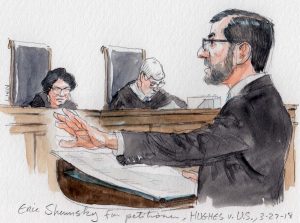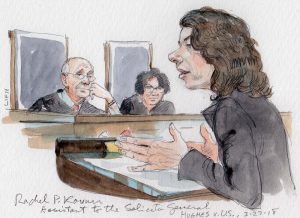SCOTUS for law students: Counting at the Supreme Court

on May 18, 2018 at 1:33 pm

Here’s a quick quiz: When does 6 plus 1 not necessarily add up to 7?
Counting vote totals can sometimes be a challenge at the Supreme Court, especially when the justices write separate opinions that take different forms and reach different conclusions.
One example came earlier this week in the sports-betting ruling, Murphy v. National Collegiate Athletic Association. In a decision written by Justice Samuel Alito, the Supreme Court invalidated a federal law, the Professional and Amateur Sports Protection Act, which prohibited states from allowing sports gambling at casinos, racetracks and other facilities within a state. Alito’s opinion was joined unambiguously and in full by five others: Chief Justice John Roberts and Justices Anthony Kennedy, Clarence Thomas, Elena Kagan and Neil Gorsuch. Justice Ruth Bader Ginsburg dissented, joined by Justice Sonia Sotomayor. That would make the vote count 6-2.
But the remaining justice, Stephen Breyer, joined most of Alito’s majority opinion but also part of Ginsburg’s dissent. So was the case decided by a 6-3 vote or a 7-2 vote?
The Supreme Court has suggested an approach for counting votes when there is no clear majority in a single opinion. More on that below. But there is no rule for how to count votes in a situation like the one created by Breyer’s hybrid vote.
Here’s what happened in Murphy v. NCAA. There were two relevant provisions of the federal law against sports gambling. The one challenged by the state of New Jersey prohibited states from running sports-gambling operations or from passing laws that would allow businesses within a state to offer sports gambling. A second provision prohibited individuals from running sports-gambling operations that are authorized by state or local law.
The Supreme Court ruled that the provision prohibiting states from authorizing sports gambling violated the constitutional principle that Congress may not “commandeer” the states by forcing them to pass laws or to refrain from passing laws. The Constitution recognizes the separate sovereignty of the states as a way of protecting individual liberty, Alito wrote for the majority. Having invalidated this provision of the federal law, Alito concluded that no other parts of the law could stand on their own and that, as a result, the entire law was unconstitutional.
Ginsburg in dissent argued that Congress was not really commandeering states but rather was simply telling states they could not do something that was prohibited by federal law. Moreover, she wrote that there was no commandeering problem with any other part of the federal law and that the prohibition on individuals running sports gambling operations pursuant to state or local law should be allowed to stand on its own.
Breyer straddled the two opinions. He agreed with the majority that the federal prohibition on states taking any steps to allow sports gambling was unconstitutional, but he agreed with Ginsburg that the rest of the statute should be saved and allowed to operate. The practical effect of his position would be that a state could not be forced to pass a law prohibiting sports gambling but that no individual could operate a sports gambling business under any state law permitting the wagering activity – as he put it, “mak[ing] New Jersey’s victory here mostly Pyrrhic.”
So the mathematical puzzle comes out this way: six votes to strike down the entire statute, one vote to strike down only part of the statute, and two votes to uphold the entire statute, or 6-1-2.
This riddle seems to have an answer. But what happens when the Supreme Court is split in a way that produces no clear majority opinion? That issue, too, has an answer, but one that may be in a state of flux.
Since 1977, the Supreme Court has followed the approach dictated in Marks v. United States. The decision in Marks involved retroactive application of the court’s standards for deciding when something is obscene and, therefore, not protected by the free speech guarantee of the First Amendment. The obscenity standard deeply split the court throughout the 1960s until the court settled on a rule in 1973 in Miller v. California. In Marks, the court decided the 1973 rule could not be applied retroactively to pre-1973 activity, meaning the justices had to settle on what pre-1973 rule to apply. This was not an easy task because of the many different views among the justices.
In Marks, the Supreme Court explained how to handle splintered decisions: “When a fragmented Court decides a case and no single rationale explaining the result enjoys the assent of five Justices, ‘the holding of the Court may be viewed as that position taken by those Members who concurred in the judgments on the narrowest grounds,’” Justice Lewis Powell wrote in a 5-4 ruling. In other words, the prescription for the past 40 years has been to comb through concurring opinions to find the least common denominator among the justices.
That answer no longer seems entirely satisfactory. On March 27, the justices heard argument in Hughes v. U.S., an appeal involving the question of whether a criminal defendant who pleads guilty in a plea deal may later benefit from changes in federal sentencing guidelines. The question has split the Supreme Court previously. In 2011, in Freeman v. United States, five justices said that defendants may benefit from the changes. Kennedy, joined by Ginsburg, Breyer and Kagan, argued that sentences in plea deals generally reflect the sentencing guidelines and, thus, should reflect changes in the guidelines. In a separate opinion, Sotomayor expressed different reasons for her view that the defendant should prevail in the case. Sotomayor thought that plea agreement sentences were based on the sentencing guidelines only some of the time and not always; as a result, she voted to allow William Freeman to benefit from guideline changes, but would not allow all defendants to do so. Four dissenters, in an opinion by Roberts, concluded that sentences in plea deals are always based on the plea bargain itself and should never change with changes in sentencing guidelines. This created a 4-1-4 split.
In recent years, lower federal courts have divided over the meaning of the Supreme Court’s splintered opinions in Freeman. The division within the Supreme Court turned on the degree to which the sentences in such plea deals came from the terms of the plea bargain or from federal sentencing guidelines, and lower courts have struggled to decide what guidance the court intended to give in Freeman.
In the recent oral argument in Hughes, the meaning of Freeman was front and center, and the justices wondered whether the Supreme Court’s approach in Marks provides sufficient guidance. Erik Hughes pled guilty to federal drug and firearms charges and was sentenced to 180 months in prison. When the sentencing guidelines range for similar charges was later lowered, Hughes moved to have his sentence reduced. A federal district court in Georgia and the U.S. Court of Appeals for the 11th Circuit rejected Hughes’ request.
During the oral argument, the justices seemed uncertain about whether the Marks approach is in need of reform. Alito commented that Marks “has been the law for 40 years, and for better or worse, it has had a big effect, I think, on what we have understood to be the jurisprudence of this Court and what the lower courts have understood to be our precedents and on the way in which Justices of this Court go about doing their job.” He suggested that the approach in Marks of finding the narrowest concurring ground “certainly could benefit from some clarification and maybe some refinement.”
And Kagan observed, “We’re in a world in which the first-best option, which is five people agreeing on the reasoning, that doesn’t exist. And so everything else is going to have some kind of problem attached to it.”
Perhaps Breyer best summed up the dilemma of how to count to five votes in the Supreme Court. “So if you ask me to write something better than Marks, I don’t know what to say,” Breyer admitted.
That may be the last word on the Supreme Court’s mathematical dilemma, at least until the court decides to clarify the rules.





